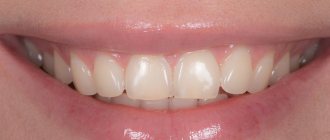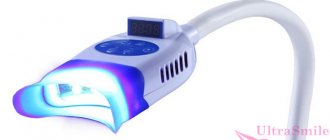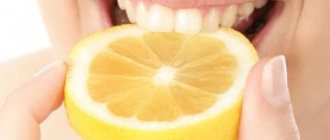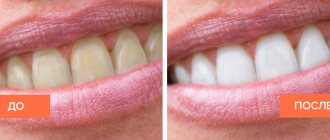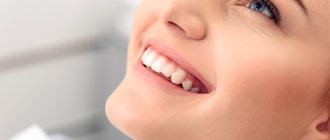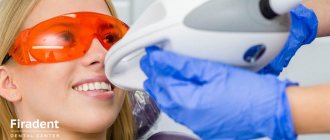Author of the article:
Soldatova Lyudmila Nikolaevna
Candidate of Medical Sciences, Professor of the Department of Clinical Dentistry of the St. Petersburg Medical and Social Institute, Chief Physician of the Alfa-Dent Dental Clinic, St. Petersburg
Acid teeth whitening is still a very popular method of home enamel lightening. But this does not mean that such a procedure is effective or safe. Many people retain the stereotype that natural remedies are not harmful to health and can be used in any dosage and concentration.
In fact, it all ends with increased tooth sensitivity, irritation of the mucous membranes and other troubles.
If you do not want to take risks, it is better to choose professional home or office whitening methods. Of course, these procedures will be much more expensive than a couple of lemons and apples, but think about it, they can turn out to be much cheaper than treating your teeth in case of an unpleasant outcome.
In addition, there is another affordable solution - using specialized whitening pastes. This solves several problems at once: saving you money, maintaining health and whitening.
These products lighten enamel much more effectively than traditional ones. Although they do not allow you to achieve a bright white color, as with professional procedures.
Beneficial features
The sunny yellow fruit of the lemon tree is a common table decoration in every home. Eating its pulp and juice allows you to:
- it is easier to tolerate colds;
- get rid of accumulated toxins and waste;
- improve your metabolism and lose extra pounds without extra effort.
The fruit is rich in vitamins A, C, group B, D, E and microelements: potassium, magnesium, sodium. Citric acid removes pigment spots from the enamel, interacts with bacteria, as a result of which the microorganisms die before they have time to form a stable plaque.
Additional buffs
Lightening your teeth with lemon will give additional results:
- reduction of toothache;
- strengthening enamel;
- reducing the frequency of relapses of inflammatory gum diseases;
- freshness of breath.
Using lemon in oral care, you can lighten your teeth by half a tone.
How does teeth whitening with baking soda and lemon work?
In themselves, soda and lemon juice are not dangerous, even beneficial components for the body. But before whitening, it is important to understand the mechanism of action of these products on dental tissue.
Baking soda (sodium bicarbonate). In everyday life, it is a snow-white powder consisting of tiny crystals.
Due to its crystalline structure, soda is a good abrasive, including for dental surfaces. When applied and further processed, it removes plaque from teeth well.
Another function of soda is to create porosity in the enamel layer. This ensures better penetration of whitening agents (in this case, lemon juice) into tooth enamel.
In addition, soda has an alkalizing effect when it enters the oral cavity. And an alkaline environment is known to be uncomfortable for various fungal microorganisms.
Lemon acid. Has a strong effect on the tissues of teeth and gums. It is able to penetrate deeply through the enamel layer, reaching the dentinal zone.
By reacting with the acid of lemon and the alkali of soda, the dentin of the tooth noticeably whitens. And the whitening effect becomes more visible.
Teeth whitening with soda and lemon is preferably performed in combination of these components. The fact is that soda neutralizes the aggressive properties of citric acid without reducing the quality of the procedure.
pros
Eating lemon helps:
- reducing inflammation;
- strengthening the immune system;
- healing gum tissue and teeth.
Lemon as a bleach:
- gives quick results;
- harmless when used correctly;
- accessible to everyone due to its low cost.
Using lemon juice to lighten the enamel, after 5-6 sessions you will notice that the color of your teeth has evened out, yellowness and pigment spots have disappeared. But there is also another side to the coin.
Advantages
The benefits of lemon as a whitening agent are as follows:
- Availability and low cost not only compared to dental procedures, but also compared to many home remedies.
- High impact. When used correctly, the fruit can make your teeth several shades lighter.
- Disinfecting effect on the oral mucosa, which eliminates the spread of bacteria and infections.
- Using lemon zest or juice strengthens the body's immune system.
- The use of an acidic product freshens breath no worse than artificial mouthwashes.
- In some cases, lemon can relieve toothache.
- A universal remedy for most people.
Minuses
This method of lightening is not suitable for everyone. If you have 1-2 teeth that have darkened due to injury or nerve removal, then they will stand out even more against the whitened ones. This darkening of the enamel is beyond the control of lemon.
It is prohibited to use the traditional method to lighten teeth:
- Children and teenagers under 18 years of age. Their dental tissues are still forming, so external influences should be minimal.
- After root canal treatment.
- People with increased tooth sensitivity.
- After removing braces. Tooth tissues are now susceptible to infections; lemon will thin the enamel and contribute to the development of caries.
- If there are cracks or chips in your teeth. Instead of benefit, you will harm yourself: once inside, the acid will corrode the tissues, spurring destructive processes.
- When teeth are damaged by caries. Lemon will enlarge cavities, which will make the situation worse.
And also preview the video on this topic:
The main thing is not to overdo it and not damage the fabric.
Causes of darkening of tooth enamel
Before using this method, you should find out the cause of the problem. It is possible that your own strength will not be enough.
There are many factors that contribute to the darkening of tooth enamel. The most common are:
- frequent consumption of strong coffee or tea;
- smoking cigarettes or pipes;
- infrequent and incomplete tooth brushing;
- carious lesions;
- damage to nerve endings due to dental trauma;
- treatment with certain drugs that can cause this phenomenon;
- presence of silver fillings;
- poisoning with salts of heavy metals;
- age-related changes.
Each of these factors has its own characteristics of influence, giving tooth enamel a certain shade.
Important! You can eliminate yellow plaque yourself using a suitable method. If your teeth have acquired a gray tint, or there are pockets of blackening, you will need the help of a specialist.
Obviously, in some cases, teeth whitening with baking soda and lemon can give the desired effect.
Top 10 recipes
There are many variations with lemon, but before using, brush your teeth with regular toothpaste. Let's look at the most common methods:
- Cut the lemon peel 2-3 cm. Rub the zest on your teeth and leave for 2 minutes.
- Take ⅛ tsp. pasta, ⅛ tsp. salt and 10 citric acid crystals. Mix and brush your teeth and then rinse your mouth. The method is aggressive, so it is allowed to be used no more than 2-3 times a month.
- Mix ⅛ tsp. baking soda and 2-3 drops of freshly squeezed lemon juice. Apply the mixture to your brush and brush your teeth as usual.
- Apply 3 drops of lemon essential oil to a cotton pad. Rub the surface of your teeth and wait 20 seconds. Secret: to prevent gum health, add 2 drops of tea tree oil.
- Mix 2 drops of hydrogen peroxide, ½ tsp. soda and ½ tsp. lemon juice. Apply the mixture to your teeth and wait 2 minutes.
- Take ¼ tsp. tooth powder and ¼ tsp. lemon juice. Mix, brush your teeth.
- Cut a piece of peel 2 by 4 cm. Chew the zest for 2 minutes. Rinse your mouth and brush your teeth as usual.
- Prepare rinse aid: 5 tsp. lemon juice and 5 tsp. water. Rinse your mouth after brushing morning and evening. Course – no more than 5 procedures per month.
- Mix ½ tsp. lemon juice, 1 tablet of activated carbon and 1/3 tsp. toothpaste. Brush your teeth.
- Cut a slice of lemon as you would when drinking tea. Squeeze the slice with your teeth. Hold for half a minute, moving it around in your mouth.
Every time after using lemon, brush your teeth with toothpaste or rinse your mouth with clean water to avoid prolonged exposure of the acid to your teeth and gums.
The recipes are all simple and do not require special preparation or the purchase of expensive ingredients. Before you start implementing your plan, look at the photos before and after lemon bleaching. Did you like the result? Then you should try traditional methods.
Teeth whitening with baking soda and lemon: advantages and disadvantages
Despite its simplicity, this method has advantages over others, namely:
- low financial costs;
- safety subject to precautions and contraindications;
- ease of implementation;
- the ability to use at any time (as an urgent option before an upcoming event);
- excellent results when used for the right reason.
It should also be noted the disadvantages of this type of bleaching. They are:
- Aggressive effects on tooth enamel from acids and alkalis, resulting in a decrease in the thickness of the enamel layer. It is especially dangerous if you do not follow the rules of the procedure.
- Not suitable for all cases of darkened teeth. Here it is important to clarify the reasons for the appearance of plaque.
Everyone must decide for themselves the balance of the pros and cons of this method individually.
Precautionary measures
For the effect to be noticeable, try not to eat or drink anything for an hour after whitening. Avoid coloring products:
- strong tea;
- coffee;
- chocolate;
- beets;
- carrots.
Don't smoke - otherwise you won't get the effect.
If you have enamel hypoplasia, do not use the traditional method, so as not to aggravate the situation.
If you are expecting a baby, postpone experiments with lemon until after childbirth: the body may react unpredictably due to changes occurring in it, for example, teeth may darken.
Abuse of the procedure will lead to weakening of the enamel. In addition, lemon juice can cause irritation of the mucous membranes, especially if you are prone to allergies.
Lemon will not work if your teeth are naturally yellowish. It only removes plaque and superficial pigmentation. Therefore, contacting a dentist in this case is the only way out.
Technique
Homemade variations on the use of lemon's teeth-lightening properties are numerous. However, they all have several common nuances . In order not to repeat ourselves in each recipe, we will talk about them separately:
- Before each procedure, as well as for some time after it, you should not eat foods containing strong dyes , for example, beets, red wine, strong tea (both black and green), coffee and others.
- Also, before starting the procedure, you should brush your teeth well using your usual brush and toothpaste.
By following these tips, you can make whitening more effective .
Reviews
There are enough people willing to try the method. You may want to read opinions before deciding to repeat an experiment someone has already done.
Marianne
“I started whitening my teeth with lemon 2 weeks ago. So far I see a modest result, but it is already there.”
Alexander
“I bleach with a mixture of lemon juice and water - I make a rinse that I use in the morning. My teeth have really become lighter, and the enamel is not damaged: the method I chose is not aggressive.”
Sergey
“My teeth are naturally white, but for the last 2 years I’ve been drinking a lot of coffee - the pace of life was stressful, I had to tone myself up in the morning. Result: the enamel has darkened. Now I brush my teeth with lemon juice, salt and toothpaste, and I’m already seeing changes for the better. By the way, I gave up coffee.”
Oleg
“I heard about the lemon whitening method a month ago. I’m conducting an experiment: I chew the zest, since I don’t have time to cook the paste. I'm happy with the effect."
Recommendations from Dr. Zubastik
Dentists support the desire of patients to have a snow-white, dazzling smile. You can try any of the suggested folk recipes to lighten your teeth. Remember: there should be no serious problems with the oral cavity, otherwise the acid will aggravate existing diseases.
Carry out the procedure from time to time: lemon really helps to lighten the enamel and get rid of plaque if it has just begun to form.
Tags: lemon, folk remedies, whitening
About the author: Dr. Zubastik
Typically, a toothache begins to subside on the way to the clinic and finally goes away after 10 minutes of sitting in line to see the dentist.
- Related Posts
- How to whiten teeth with hydrogen peroxide at home
- How to get rid of caries at home?
- How to quickly remove bad breath: 10 ways
« Previous entry
Clinical researches
Clinical studies have proven that regular use of professional toothpaste ASEPTA GENTLE WHITENING for a month allows you to lighten tooth enamel by 1.5 tones, increases anti-caries effectiveness by 3.4 times and increases enamel remineralization by 2.6 times.
Sources:
- Report on determining/confirming the preventive properties of toothpaste “ASEPTA PLUS” GENTLE WHITENING” Author: doctor-researcher A.A. Leontyev, head Department of Preventive Dentistry, Doctor of Medical Sciences, Professor S.B. Ulitovsky First St. Petersburg State Medical University named after. acad. I.P. Pavlova, Department of Preventive Dentistry
- Report on the determination/confirmation of the preventive properties of personal oral hygiene products “ASEPTA PLUS” Remineralization doctor-researcher A.A. Leontyev, head Department of Preventive Dentistry, Doctor of Medical Sciences, Professor S.B. Ulitovsky First St. Petersburg State Medical University named after. acad. I.P. Pavlova, Department of Preventive Dentistry
- Clinical studies of antisensitive toothpaste “Asepta Sensitive” (A.A. Leontyev, O.V. Kalinina, S.B. Ulitovsky) A.A. LEONTIEV, dentist O.V. KALININA, dentist S.B. ULITOVSKY, Doctor of Medical Sciences, Prof. Department of Therapeutic Dentistry, St. Petersburg State Medical University named after. acad. I.P. Pavlova
- Report on determining/confirming the preventive properties of toothpaste “ASEPTA PLUS” COFFEE and TOBACCO Author: doctor-researcher A.A. Leontyev, head Department of Preventive Dentistry, Doctor of Medical Sciences, Professor S.B. Ulitovsky. First St. Petersburg State Medical University named after. acad. I.P. Pavlova, Department of Preventive Dentistry
